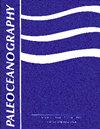Closing an early Miocene astronomical gap with Southern Ocean δ18O and δ13C records: Implications for sea level change
引用次数: 20
Abstract
We present orbital-scale resolution (~10-kyr) benthic foraminiferal δ18O and δ13C records from the Kerguelen Plateau (Ocean Drilling Program [ODP] Sites 751 and 747) from 14.5-20.0 Ma spanning the Miocene climate optimum (MCO; 15-17 Ma). Our records fill a critical gap from ~17-18 Ma, a time when many other deep-sea records are affected by dissolution. We tested the fidelity of published magneto-biostratigraphic age models for these sites by astronomically tuning to the 405-kyr eccentricity cycle. A comparison of spectral estimates between the untuned and tuned records, as well as coherency with Laskar's (2004) eccentricity solution, revealed quasi-100-kyr cyclicity in δ18O and δ13C. There is only a weak signal associated with the 41-kyr obliquity cycle, likely due to the 10-kyr sampling limiting resolution. The δ18O variations point to persistent 405- and quasi-100-kyr modulations of temperature and sea-level changes through the early to middle Miocene as predicted by astronomical solutions, with changing dominance of the 100- and 41-kyr beat. Comparison of δ18O records with early to middle Miocene sequences from the New Jersey shelf, northeast Australian margin, Bahamas, and Maldives suggests that the dominant sea-level period preserved is the 1.2-Myr obliquity cycle, with sequence boundaries associated with δ18O increases or maxima. On the New Jersey margin, higher order sequences reflect the quasi-100-kyr eccentricity cycles as modulated by 405-kyr cycles. We suggest that “nesting” of stratigraphic cycles is a function of: 1) pervasive (though changing) Milankovitch forcing of global mean sea-level change; and 2) preservation that depends on sufficient sediment supply and accommodation.用南大洋δ18O和δ13C记录缩小中新世早期的天文差距:对海平面变化的影响
本文给出了来自克格伦高原(Ocean Drilling Program [ODP] Sites 751 and 747) 14.5-20.0 Ma的轨道尺度分辨率(~10-kyr)底栖有孔虫δ18O和δ13C记录,跨越中新世气候最佳(MCO;15 - 17日)。我们的记录填补了~17-18 Ma的关键空白,这一时期许多其他深海记录受到溶解作用的影响。我们通过天文校正到405 kyr的离心旋回,测试了这些地点已发表的磁生物地层年龄模型的保真度。通过比较非调谐和调谐记录之间的光谱估计,以及与Laskar(2004)的偏心率解的一致性,揭示了δ18O和δ13C的准100 kyr周期。只有一个微弱的信号与41kyr的倾角周期有关,可能是由于10kyr的采样限制分辨率。δ18O的变化表明,在早至中新世中期,温度和海平面变化持续存在405-和准100-kyr的调制,其中100-和41-kyr的调制占主导地位。与新泽西陆架、澳大利亚东北缘、巴哈马和马尔代夫早中新世至中中新世层序的δ18O记录比较表明,保留的主要海平面期为1.2 myr倾角旋回,层序边界与δ18O增加或最大值有关。在新泽西边缘,高阶层序反映了经过405-kyr旋回调制的准100-kyr偏心旋回。我们认为地层旋回的“嵌套”是以下因素的函数:1)全球平均海平面变化的普遍(尽管在变化)米兰科维奇强迫;2)保存取决于足够的沉积物供应和容纳。
本文章由计算机程序翻译,如有差异,请以英文原文为准。
求助全文
约1分钟内获得全文
求助全文

 求助内容:
求助内容: 应助结果提醒方式:
应助结果提醒方式:


